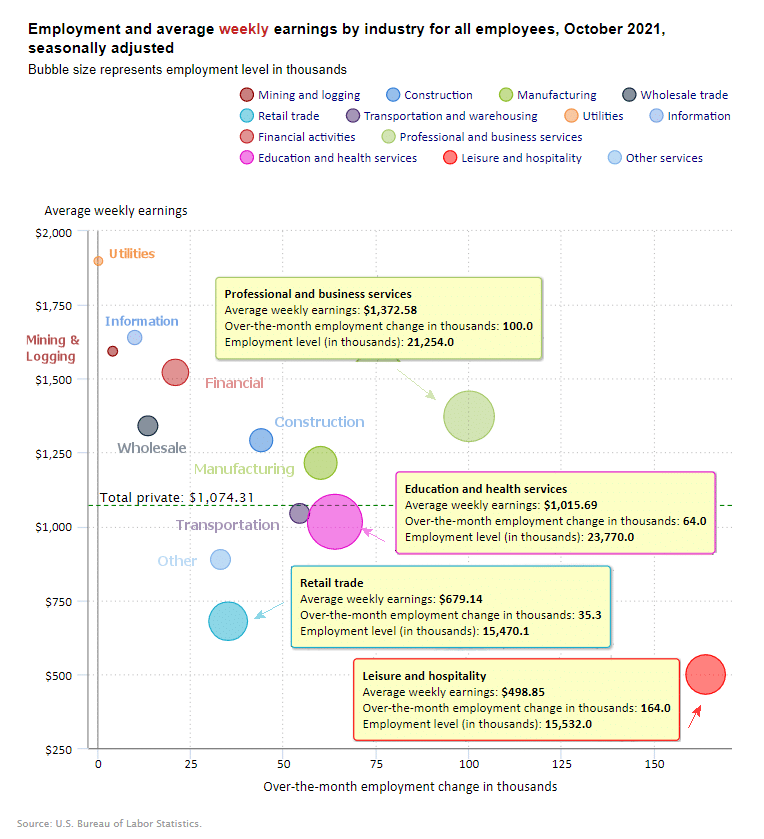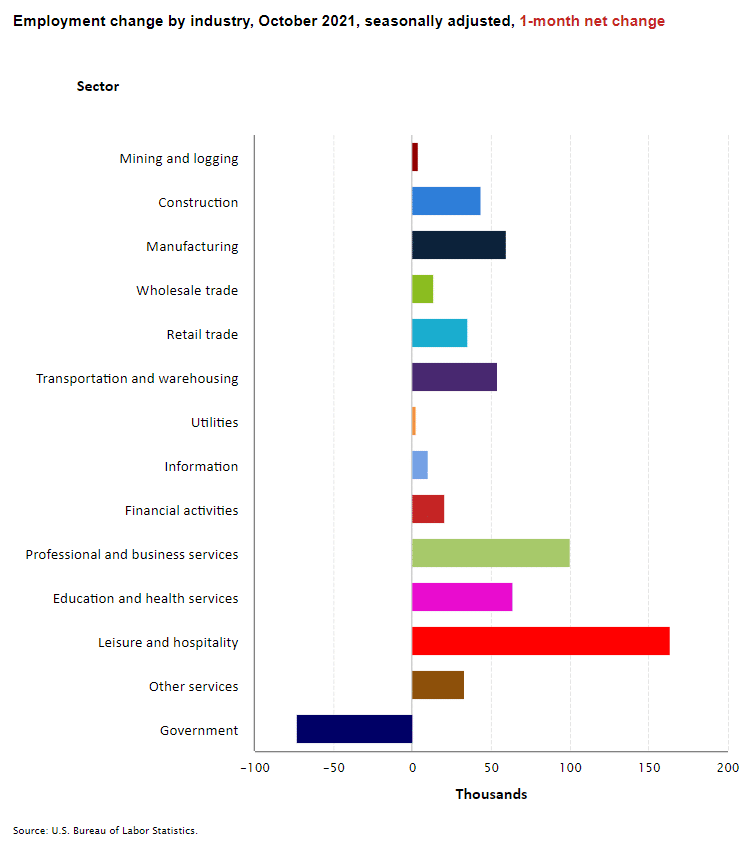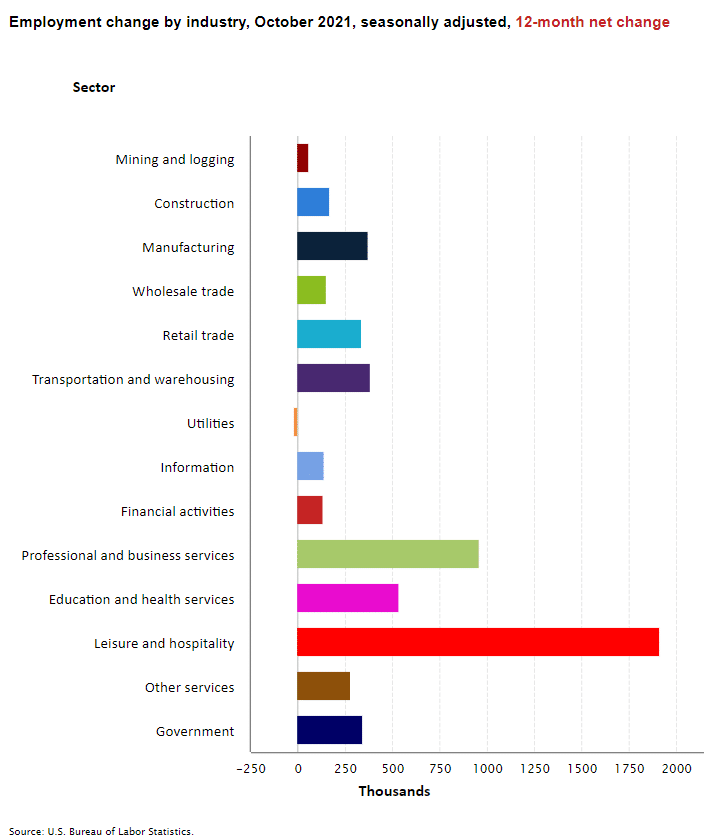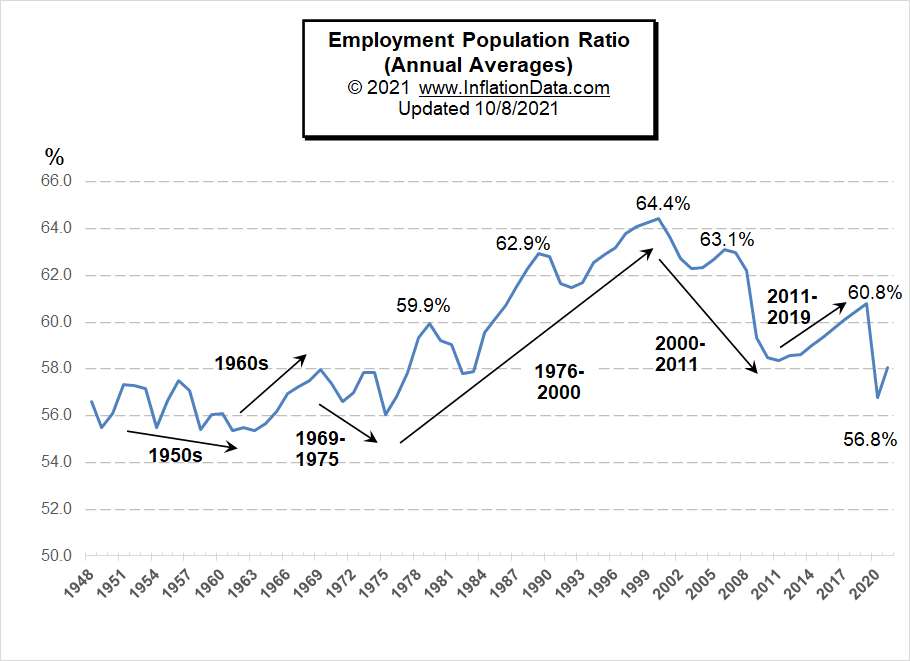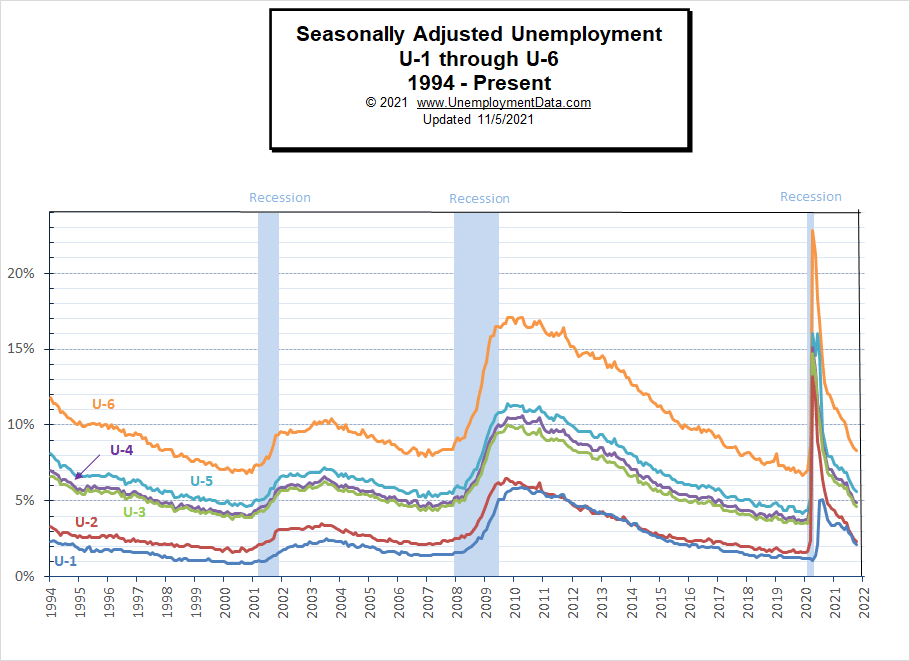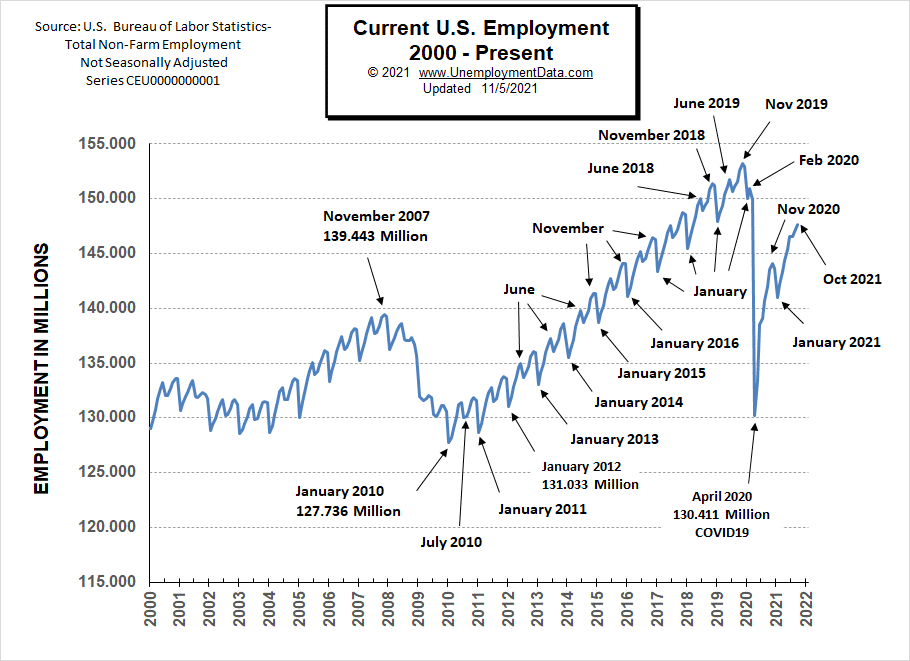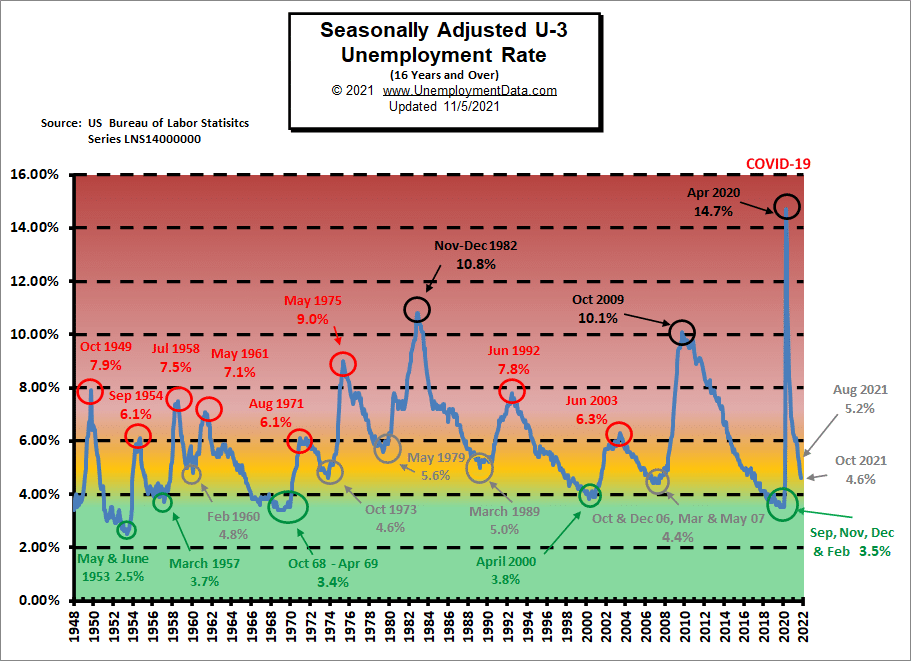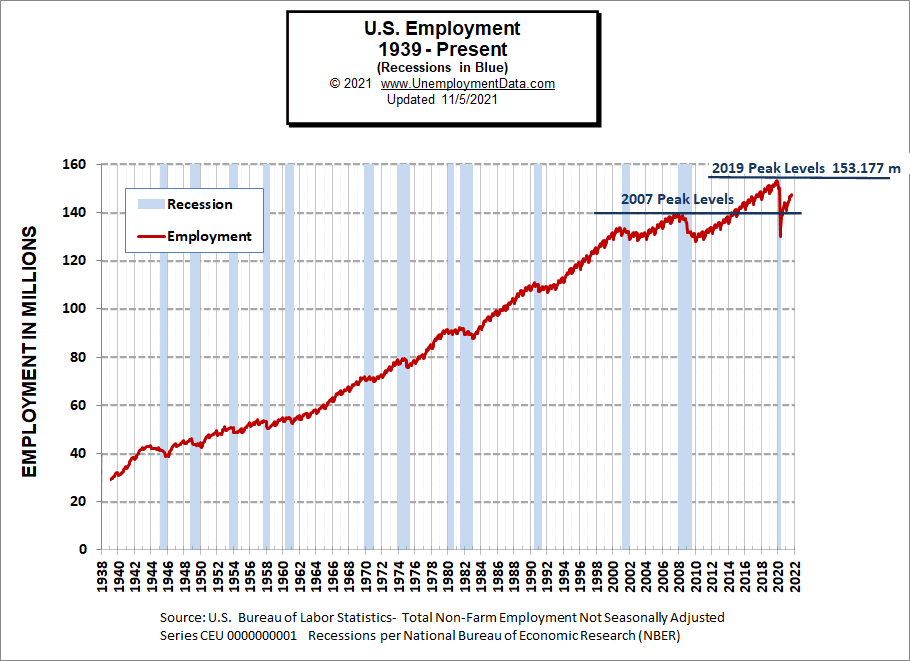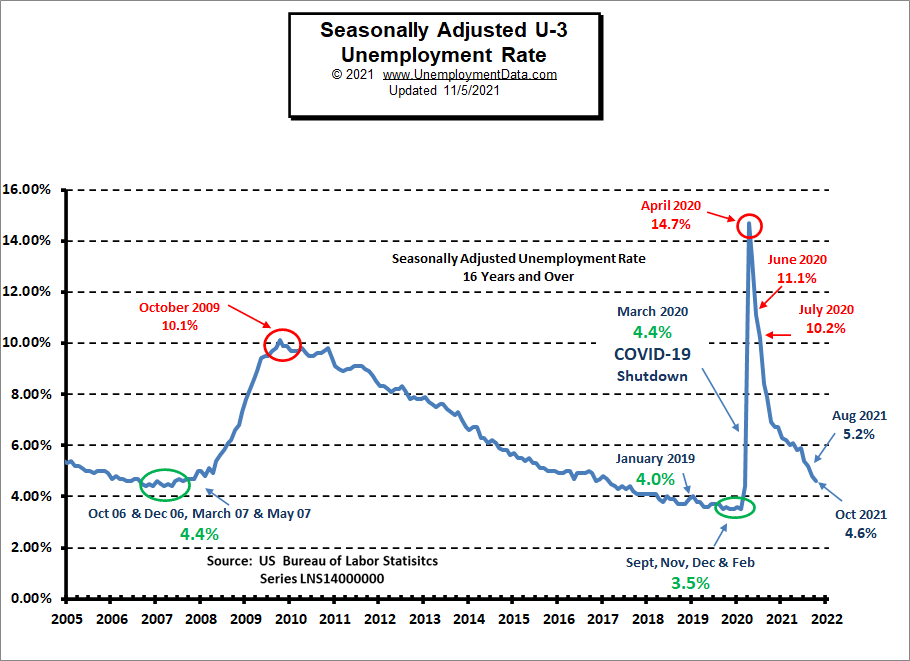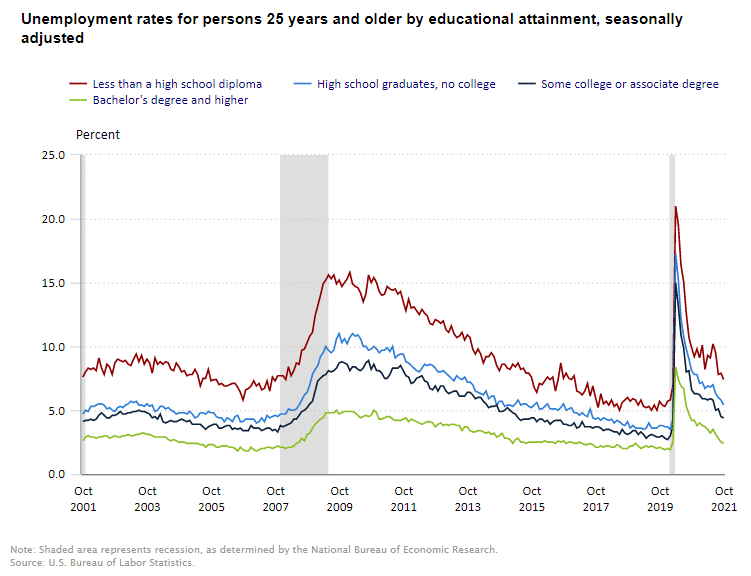October 2021 Unemployment report from the Bureau of Labor Statistics (BLS)
- Unadjusted U-3 was Down from 4.6% to 4.3%
- Adjusted U-3 was Down from 4.8% to 4.6%
- Unadjusted U-6 was Down from 8.1% to 7.7%
- Labor Force Participation unchanged at 61.6%
- Unadjusted employment rose from 147.659 million to 149.217 million
These numbers are generally an improvement over last month (except Labor Force Participation), in line with market expectations. Typically October and November are up months for employment with Seasonal hiring for the Holidays.
According to the Commissioner of the U.S. Bureau of Labor Statistics:
“Nonfarm payroll employment rose by 531,000 in October, and the unemployment rate edged down by 0.2 percentage point to 4.6 percent.
Job growth was widespread, with notable job gains in leisure and hospitality, in professional and business services, in manufacturing,
and in transportation and warehousing. Employment declined in public education over the month.”
As usual, they are talking about “Seasonally Adjusted Jobs” from the “Current Population Survey (CPS)” rather than looking at the results reported by actual companies in their “Current Employment Statistics survey (CES)”
But looking at the CES report we see…
Originally the BLS reported 147.682 for September which they adjusted to 147.659 million. For October they are currently saying employment is 149.217 million.
which is actually an increase of 1,535,000 jobs based on their original estimates or an increase of 1,558,000 based on their updated numbers.
Employment by Sector
The employment “bubble chart” shows each sector separately (on a seasonally adjusted basis). Bubble Size tells us total employment for each industry (i.e., larger bubbles mean more people are employed in that sector). Bubble location on the chart tells us, Change in Employment Levels over the most recent month… The further to the right the bubble, the larger the number of jobs, and the higher up on the chart, the larger the average salary.
Leisure & Hospitality was the largest gainer again this month with a gain of 164,000 jobs, Professional & Business Services, and Retail were also gainers. Education & Health had lost 7,000 jobs last month but made up for it this month with a 23,770 gain.
Average weekly wages rose from $1,073.58 in September to $1,074.31 in October.
Employment and Average Weekly Earnings by Industry
October 2021, Seasonally Adjusted
| Industry | Monthly Increase | Average Weekly Earnings | Employment Level |
| Total Private Employment | 604,000 | $1,074.31 | 126,393,000 |
| Mining and Logging | 4,000 | $1,593.09 | 651,000 |
| Construction | 44,000 | $1,291.81 | 7,498,000 |
| Manufacturing | 60,000 | $1,215.05 | 12,529,000 |
| Wholesale trade | 13,500 | $1,340.52 | 5,737,700 |
| Retail trade | 35,300 | $679.14 | 15,470,100 |
| Transportation and Warehousing | 54,400 | $1,044.13 | 5,972,000 |
| Utilities | 200 | $1,898.40 | 536,700 |
| Information | 10,000 | $1,639.44 | 2,792,000 |
| Financial Activities | 21,000 | $1,521.38 | 8,882,000 |
| Professional and Business Services | 100,000 | $1,372.58 | 21,254,000 |
| Education and Health Services | 64,000 | $1,015.69 | 23,770,000 |
| Leisure and Hospitality | 164,000 | $498.85 | 15,532,000 |
| Other Services | 33,000 | $888.08 | 5,768,000 |
This chart provides another way to look at these monthly numbers. This chart includes government jobs which lost 73,000 jobs on top of the 125,000 lost last month.
Looking at Employment Change by Industry over the last 12 months we can see the improvement in all the sectors except Utilities which tend to be very stable year over year.
Source: BLS
Employment-Population Ratio
Recently we added more coverage of the Employment-Population Ratio. This chart shows the actual percentage of the population that is working, unlike the Labor Force Participation Rate, which shows the portion of the population that is working or looking for work.
In this chart, we can see the long-term trends in the percentage of the population that is working. For more information and to see the full commentary on these trends, see Employment-Population Ratio.
U1 through U6 Unemployment Rates
For more information about the various measurements of unemployment, see What Is U-6 Unemployment?
Current Employment
October employment ticked up, but overall, employment is still well below peak levels of November 2019 despite the population growing by roughly 1.7 million.
See Current Employment for more info.
Unemployment Normalizing
In the chart below, the “red zone” indicates things are really bad. Historically “Bad” for the U-3 usually starts at around 6.5%-7% and stops at about 10%, with only three occasions getting above 10%. In 2020 COVID sent unemployment from really good (green zone) to really bad virtually overnight.
The yellow zone (from about 4% to 6%) is the normal operating range, and when unemployment stays in this range, the economy is generally doing OK. Below 4%, the economy is doing great and above 7%, and the economy is in trouble. Currently, the adjusted U-3 unemployment rate has fallen from the horrendous 14.7% of April 2020 down to 4.6% in October.
Historical Employment
A high unemployment rate is a significant component of a recession. The blue bars in the chart below indicate official recessions, while the red line shows the Historical Employment Data. Several years after the 2008 crash, employment finally rose above the 2007 peak levels. Then in April 2020, COVID drove the number of people employed below the 2007 peak and approached the lows of the 2008-2010 crash. By August 2020, employment had rebounded above the 2007 peak level, but it remains below the 2019 peak.
See Historical Employment Data for more info.
Current Seasonally Adjusted Unemployment
 Unemployment by Education
Unemployment by Education
Those with the least education always have the worst employment prospects and are the first to be laid off when the economy gets bad because they can easily be replaced later. Those with specialized knowledge and/or skills are retained at all costs. The unemployment rate for those with a Bachelors’s degree (or above) is typically between 2% and 3%, except when times are really terrible.
Labor Force Participation Rate
The Labor Force Participation Rate (LFPR) appears to be bouncing between 61.4% and 61.7%.
As we explain in the page on the Labor Force Participation Rate, the BLS has a strange definition of Labor Force Participation, and so if you “want a job” but don’t look, you aren’t in the Labor Force.
If you would like to receive this monthly report and other article updates, click here. You can unsubscribe at any time.
Here are some articles you might enjoy in case you missed them:
Read more on UnemploymentData.com.
- The Spectacular Benefits of a Sales And Marketing Career
- Got A New Job Out Of State? How To Find A New Home Fast
- Save Money by Getting Disability Insurance Through Your Work
- September Unemployment Disappointing
- Great Careers: No College Degree Necessary
From InflationData.com
- How Insidious Inflation Affects the Affordability of Tuition and Fees
- Do Housing Prices Always Go Up?
- The Travel Industry, the Pandemic and U.S. Inflation
- September Inflation Rebounds
- Why is a Little Bit of Inflation Considered Good for the Economy?
- How to Prepare for Inflation
- Safe-Haven Investments that Protect Your Capital From Rising Inflation
- 9 Inflation Books You Must Read
- Hyperinflation Strikes Lebanon… Again
From Financial Trend Forecaster
- Moore Inflation Predictor
- NYSE ROC
- NASDAQ ROC
- 5 Revolutionary Developments in the Financial Industry
- How Is Technology Affecting Global Trading Markets
- Why Wearable Brand Merchandise is On Trend
- From Pandemic To 2021 Supply Chain Disruption
- Batteries: New Sea-Water Based Battery to Replace Lithium
- Farming: Discovering New Ways to Feed the Planet
- Fintech: The New Financial Management Disruptive Technology
- Record Credit Card Debt Reduction
- A Change May Be Nigh for Real Estate
- Will China’s Crackdown Send Bitcoin’s Price Tumbling?
- Why a Financial “Panic” May Be Just Around the Corner
- “Kiss of Death” Stock Market Indicator
- Will Oil Prices Skyrocket in the Aftermath of Hurricane Ida?
- Be Prepared “Or Else”
- The Maniacal Residential Real Estate Market
From OptioMoney.com
- Creative Ways to Make Money In Retirement
- Covering the Cost of Cancer
- What to Consider When Shopping for Health Insurance
- How Does Bitcoin Mining Work? The Ultimate Guide
- Moving to a Cheaper City: Is It Worth It?
- How to Prepare for a Severe Storm
- Is Downsizing Right for You?
- The Best Investment Advice for Beginners
- Secrets for Lucrative Investment Properties
From Your Family Finances
- Start Your Kids Right with a Credit Union Account
- Make Sure You’re Protected from the Unexpected
- When You Should Not Trade-In Your Car
- Could Moving to a Small Town Save You Money?
- Should You Buy A Home With Cracks In The Foundation?
- 5 Ways You Can Save More Money Every Month
- Bargain Retirement Overseas in Malaysia?
- How to Prepare Your Finances for Life Changes
- How Modern Tech Can Enhance Your Real Estate Investing

